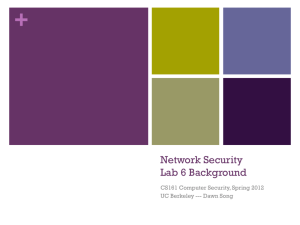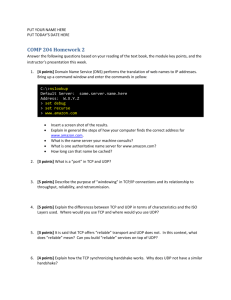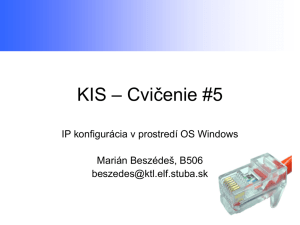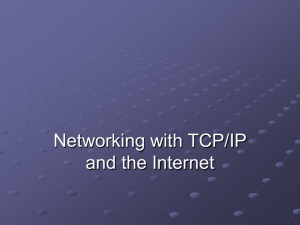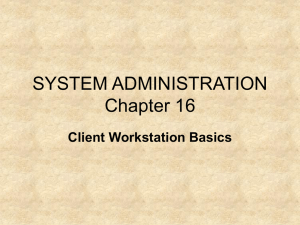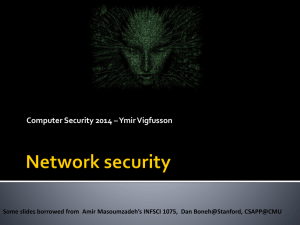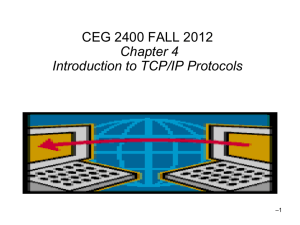TCP or UDP
advertisement
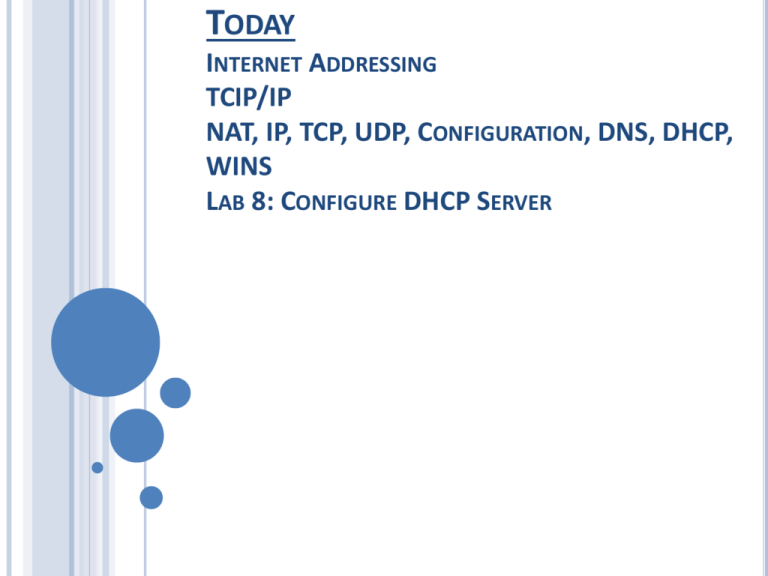
TODAY INTERNET ADDRESSING TCIP/IP NAT, IP, TCP, UDP, CONFIGURATION, DNS, DHCP, WINS LAB 8: CONFIGURE DHCP SERVER NETWORK ADDRESS TRANSLATION (NAT) Allows unregistered private network addresses to communicate with legally registered IP addresses Advantages Hides internal IP addresses, thus providing security Eliminates need for multiple registered IP addresses Allows multiple ISDN (Integrated Services Digital Network) connections to be combined into one Internet connection IP CONFIGURATION DOMAIN NAME SYSTEM (DNS) Makes it easy to identify and find hosts on Internet When domain name is entered, it is converted to its IP address FULLY QUALIFIED DOMAIN NAME (FQDN) Needed to locate a host on a large network Example of an FQDN: station2.xyzcorp.com *A combination of the host name and domain name. Operating systems such as Linux, and Windows 2000 and later follow the rules of Fully Qualified Domain Names when creating their network structure. (FQDN VS NETBIOS NAME) Fully Qualified Domain Name is limited to 63 characters. NetBIOS names is a computer name limited to 15 characters. Many symbols allowed in NetBIOS names cannot be used in FQDN. (;:”<>*+=\/?,) To allow for communication between legacy systems and ones that use host names the computer names are converted automatically. DNS STRUCTURE AND OPERATION Hierarchical structure Root - The authoritative name servers that serve the DNS root zone Top-level domains— .com,.edu,.gov,.net,.org Second-level domains—mit.edu Subdomains(any level domain located beneath the secondary domain)— campus.mit.edu, faculty.mit.edu AKA (lower-level domain) DNS STRUCTURE AND OPERATION Resolver A software program located on a host that queries a DNS server to resolve a host name to an IP address • Once information is found it is returned to the resolver • If top level • server cannot resolve request it is• passed on to the root sever Domain names are placed in cache for future requests. If not in cache Top level DNS is contacted Research .mit.edu • DNS server the host is connected to as part of a workgroup or domain. • OR it could be an ISP WINDOWS INTERNET NAMING SERVICE (WINS) Windows NT server operating systems used WINS to resolve NetBIOS names to IP addresses Windows 2000 and later use the Dynamic DNS, which incorporates the WINS and DNS features IP, TCP, AND UDP Three most commonly used protocols in TCP/IP suite IP establishes a link between nodes but does not verify the data is delivered correctly – connectionless protocol TCP ensures packets arrive intact and in correct order connection-oriented TCP can break large amounts of data into smaller packets and UDP cannot UDP sends a single packet to transmit control information and data - connectionless protocol TCP OR UDP The selection of TCP or UDP depends on three factors The software used in the upper layers of the OSI model The amount of data to be sent If a connectionless or connectionoriented transport of data is desired OSI MODEL AND TCP/IP UDP FRAME UDP and TCP Rely on the IP Frame format for IP address Destination and source Used to transfer small blocks of data and commands TCP FRAME Used to reassemble data in a correct order IP FRAME Final step is to encapsulate the entire set of protocol frames in a frame matching the network standard e.g Ethernet ASSIGNING IP ADDRESSES Static addressing or dynamic addressing can be used to assign IP addresses to hosts A static IP assignment is entered manually when the NIC is configured A server running the Dynamic Host Configuration Protocol (DHCP) issues an IP address to a host when it joins the network (dynamic IP assignment) an IP address that is issued automatically. Typically when a computer boots and joins the network. The default DHCP IP lease period is 8 days. DYNAMIC ADDRESSING AUTOMATIC PRIVATE IP ADDRESSING (APIPA) Used when the host is unable to access a DHCP server Host automatically generates an IP address in the range of 169.254.0.1 to 169.254.255.254 Uses the APIPA address to communicate with other workstations on the same segment. This addressing is compatible with all Microsoft products starting with Windows 98 This was not necessary in previous operating systems due to NetBEUI protocol which uses MAC addresses to communicate with workstations on the same segment TCP/IP PORTS AND SOCKET A port number combined with an IP address (socket) is used to create a virtual connection E.G. 192.168.20.45:80 Socket technology allows multiple, simultaneous services to run between a server and a workstation. EXAMPLES OF WELL-KNOWN PORT NUMBERS Service or Protocol Port Number FTP 20, 21 SSH 22 Telnet 23 SMTP 25 DNS 53 TFTP 69 HTTP 80 POP3 110 NNTP 119 NTP 123 IMAP4 143 HTTPS 443

